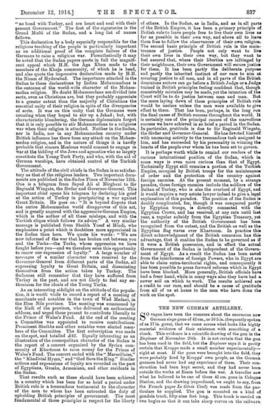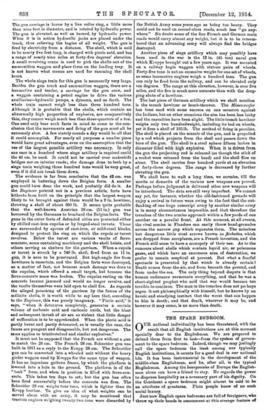THE NEW GERMAN ARTILLERY.
SO vague have been the rumours about the enormous new German siege guns of 42 cm., or 16.5 in. (frequently spoken of as 17 in. guns), that we come across what looks like highly material evidence of their existence with something of a shock. This evidence is a scientific drawing of the gun in the Engineer of November 20th. It is not certain that the gun has been used in the field, but the Engineer says it is pretty certain that Krupps made a small number experimentally— eight at most. If the guns were brought into the field, they were probably fired by Krupps' own people, as the German gunners had never had any experience of them. Their con- struction had been kept secret, and they had never been outside the works at Essen before the war. A traveller saw what he believed to be one of these 42 cm. guns in Cologne Station, and the drawing (reproduced, we ought to say, from the French paper Le Genie Civil) was made from the par. titulars he supplied. The gun is mounted on a kind of gondola track, fifty-nine feet long. This truck is carried on two bogies so that it can take sharp curves on the railways.
The gun carriage is borne by a live roller ring, a little more than nine feet in diameter, and is rotated by hydraulic power. The gun is elevated, as well as turned, by hydraulic power. When it is in action hydraulic jacks are placed under the truck, thus relieving the bogies of all weight. The gun is fired by electricity from a distance. The shell, which is said to be nearly five feet long, is charged with picric acid, and has a range of nearly nine miles at forty-five degrees' elevation. A small revolving crane is used to pick the shells out of the ammunition waggon and place them on the loading tray. It is not known what means are used for ramming the shell home.
The whole siege train for this gun is necessarily very large. Besides the gun truck and ammunition waggon, there are a locomotive and tender, a carriage for the gun crew, and a waggon containing a petrol engine to drive the various auxiliaries—hydraulic pumps, a dynamo, and so forth. The whole train cannot weigh less than three hundred tons. Although it is probable that the shells, which contain an abnormally high proportion of explosive, are comparatively thin, they cannot weigh much less than three-quarters of a ton. One need only bear such facts in mind to come to the con- clusion that the movements and firing of the gun must all be extremely slow. A few stately rounds a day would be all that it could accomplish. For nearly all purposes a smaller piece would have great advantages, even on the assumption that the axe of the largest possible artillery was necessary. In only one case in a hundred where siege artillery is required could the 42 cm. be used. It could not be carried over makeshift bridges nor on inferior roads; the damage done to both by a siege train weighing three hundred tons would be very great, even if it did not break them down.
The evidence is far from conclusive that the 42 cm. was employed in battering down the Belgian forts. A smaller gun could have done the work, and probably did do it. As the Engineer pointed out in a previous article, forts have hitherto been built on the principle that the largest weapon likely to be brought against them would be a 9 in. howitzer, throwing a shell of about 300 lb. It seems quite probable that the well-known Austrian 28 cm. (11 in.) gun was borrowed by the Germans to bombard the Belgian forts. The guns in the outer forts of defended cities are protected either by chilled cast-iron cupolas or by forged-steel turrets. These are surrounded by aprons of cast-iron, or mild-steel blocks, designed to protect the ring on which the cupola or turret revolves. Below the turret are various vaults of ferro- concrete, some containing machinery and the shell hoists, and others serving as shelters for the garrison. When a cupola or turret is struck by a 748 lb. shell, fired from an 11 in. gun, it is sure to be penetrated. But high-angle fire from howitzers is uncertain, and the Belgian forts were destroyed, as a matter of fact, not because much damage was done to the cupolas, which offered a small target, but because the ferro-concrete mass was broken. The cupolas resting on the concrete became jammed and would no longer revolve, and the vaults themselves were laid open to shell fire. As regards the alleged poisoning of the garrison by the fumes of the melinite shells, it is worth while to say here that, according to the Engineer, this was purely imaginary. "Picric acid," it says, " when it detonates completely, generates a certain volume of carbonic acid and carbonic oxide, but the blast and subsequent inrush of air are so violent that little danger of suffocation is to be apprehended. When the picric acid is partly burnt and partly detonated, as is usually the case, the fumes are pungent and disagreeable, but not dangerous. The same applies to trinitrotoluol and similar explosives."
It must not be supposed that the French are without a gun to match the 28 cm. The French 28 cm. Schneider gun was built in 1911 as a reply to the Krupp 28 cm. The Schneider gun can be converted into a wheeled unit without the heavy girder waggon used by Krupp for the same type of weapon. It has an ingenious gallows frame, by which the platform is lowered into a hole in the ground. The platform is of the " tank " form, and when in position is filled with ferro-con- trete. This takes ten days to set ; but the gun has often been fired successfully before the concrete was firm. The Schneider 28 cm. weighs four tons, which is lighter than its Krupp brother. To give an idea of what weights can be moved about with an army, it may be mentioned that traction engines weighing twenty-two tons were discarded by
the British Army some years ago as being too heavy. They could not be used on second-class roads, much less "go any- where." No doubt some of the fine French and German main roads would carry almost any weight, but it is to be remem- bered that an advancing army will always find the bridges destroyed.
Another piece of siege artillery which may possibly have been used in the war is the 12 in. (45 ton) naval gun
which Krnpps brought out a few years ago. It was mounted
on a railway bogie waggon with sixteen pairs of wheels. Forty-five tons is not an excessive weight for one set of wheels,
as seme locomotive engines weigh a hundred tons. The gun can only be fired from the railway, and can he elevated only ten degrees. The range at this elevation, however, is over five miles, and the fire is much more accurate than with the drop- ping shots of a howitzer.
The last piece of German artillery which we shall mention is the trench howitzer or bomb-thrower. The lifinenwerfer has been used with some success on one occasion against the Indians, but on other occasions the aim has been less lucky and the casualties have been slight. The little trench howitzer weighs only two hundredweight, including its bed on wheels, yet it fires a shell of 185 lb. The method of firing is peculiar. The shell is placed on the muzzle of the gun, and is propelled by a rod which projects from the shell and passes down the
bore of the gun. The shell is a steel sphere fifteen inches in diameter filled with high explosive. When it is driven from
the gun the projecting rod is released (as though the stick of a rocket were released from the head) and the shell flies on alone. The shell carries four hundred yards at an elevation of forty-three degrees. The range is decreased by further elevating the gun.
We shall have to wait a long time, we surmise, till the merits or demerits of the various new weapons are proved.
Perhaps before judgment is delivered other new weapons will be introduced. The data are still very imperfect. We cannot say yet, for instance, whether the old-fashioned grenade will enjoy a revival in future wars owing to the fact that the out- flanking of one huge conscript array by another similar army is in many circumstances impossible. and that therefore the trenches of the two armies approach within a few yards of one another on a parallel front. At this moment, at all events, the rival armies in Flanders can easily throw hand-grenades across the narrow gap which separates them. The noiseless but dangerous little steel arrows known as frchettes, which are dropped from aeroplanes, are a French invention, and the French still seem to have a monopoly of their use. As to the
rumours about shells which contain liquid air, or poisonous gases, and which have an enormous area of destruction, we
prefer to remain sceptical at present. But what a fearful spectacle is presented by that which is already certain! Death comes from the air, and from beneath the ground, and from under the sea. The only thing beyond dispute is that
human endurance surmounts everything, and that he was a short-sighted prophet who said that war would become too
terrible to continue. The man in the trenches does not pet hapa argue it out philosophically with himself, but he knows by an heroic and steadying instinct that the worst that can happen to him is death; and that death, whatever it may be, and however it may come, is no more than death.















































 Previous page
Previous page